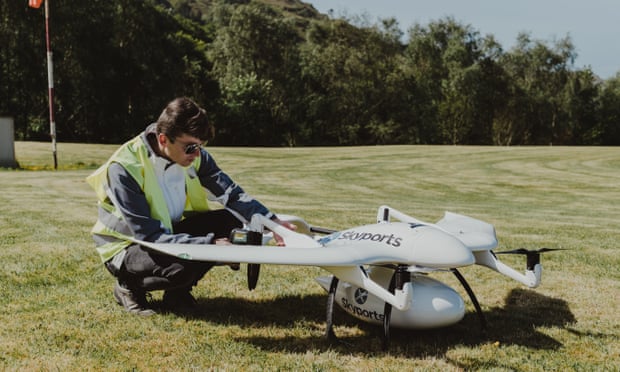Blog entry by Bruce McPherson

A Skyports worker with a delivery drone on the Isle of Mull. The aircraft can provide NHS workers with PPE and other supplies. Photograph: Skyports
Isle of Mull among areas trialling use of unmanned aircrafts to distribute supplies
Ten weeks on from the peak of the coronavirus pandemic there are still acute shortages of personal protective equipment (PPE) and Covid-19 testing kits across the UK, particularly in rural and isolated locations.
On the Isle of Mull in the Inner Hebrides, however, the vital supplies arrive up to four times a day. They are flown in from the mainland by drone in a trial that could lead to the NHS regularly using drones to fly equipment and medical samples to many of Scotland’s roughly 90 inhabited islands.
The unmanned aircraft industry hopes that showing the public drones can help in the fight against Covid-19, perhaps even save lives by speeding up test time turnarounds, could pave the way for wider adoption of drone technology.
US investment bank Goldman Sachs believe drones could spawn a $100bn (£80bn) market if governments around the world allowed them to be used for everything from policing and border patrol to surveying vital infrastructuresuch as bridges, or even replacing moped riders to deliver pizzas and fried chicken direct to your door.
It’s not just the 2,800 people on Mull who are receiving PPE by drone in the pandemic. Another trial is carrying PPE from Lee-on-the-Solent to the Isle of Wight. Both trials required approval by the Civil Aviation Authority (CAA) as rules ban drone flights beyond the line of sight of the remote pilot.
Drones are also being used to send coronavirus tests back and forth to up to 2,500 hospitals and rural health outposts in Rwanda and Ghana. This week the first US medical drone flight despatched a consignment of PPE to frontline workers in North Carolina.
Stephen Whiston, head of strategic planning for the Argyll and Bute health and social care partnership said drones could transform the speed with which doctors diagnose and treat patients across the authority’s rural community which is spread across 2,500 sq miles of western Scotland. This includes Mull and several other islands.
Whiston said: “Laboratory pick ups from GP surgeries up here can be very inefficient, with delays ranging from a couple of hours to two days if ferries are missed. When you’re talking about serious and developing conditions those sort of delays are very serious.”
The 16km (10 mile) flight from Lorn and Islands district general hospital in Oban, on the mainland, to Mull and Iona community hospital in Craignure, on the north-west of the island, takes about 15 minutes compared with between 90 minutes to six hours by road and ferry.
Whiston said the two-week drone delivery trial, which is being run in partnership with drone operator Skyports and defence and technology company Thales, was planned before coronavirus struck but has been accelerated by the pandemic.
A second test this winter is crucial because “the Scottish weather can be very challenging”, says Whitson. If it’s successful he thinks drones could be deployed across NHS Scotland. “We would look to link up more of our islands,” he said. “And we have been sharing what we’re doing here with colleagues across Scotland, and there is significant interest about using it in the Western Isles, Clyde and the Grampians.”
Raymond Li, head of air strategy and marketing for Thales, which is providing technology and flight planning , said the pandemic had proved very timely for the drone industry as regulators acted to speed up the approval process to start trial flights.
“This will also allow us to show the public the societal benefits of drones,” he said.
“People will have seen the headlines about the drone at Gatwick [in 2018, when hundreds of flights were cancelled when a rogue drone flew over the runway] and been worried about drones. Covid-19 may well change how people see their usefulness. They will see that drones can help save lives, and people will see the benefits to themselves and their families.”
In the current trial, using a German-made Wingcopter drone, a trained operator must pilot the drone and actively direct it via a live video feed. But future costs could be greatly reduced by allowing drones to fly missions autonomously. Li said: “Just imagine a fleet of thousands of drones doing everything from search and rescue, and border patrol to delivering food. There could even be air taxis [in which people are transported in drones without pilots].”
Holly Jamieson, head of future cities at Nesta Challenges, a charity supporting innovation, said the real-world use of drones would help prompt a public conversation on the use of the technology and its implications on personal privacy.
“You have to remember that the coronavirus pandemic is a pretty exceptional event and the public are a lot more accepting about a lot of things we wouldn’t put up with in normal times. It could be the same with drones,” she said.
Research by Nesta suggests using drones to assist public services, including transporting NHS tests and samples and supporting the police and fire services, could save the public sector £1.1bn by 2035.
Jamieson said: “People are concerned about the impact on their privacy and the noise. Public engagement is absolutely key. We need to be asking who should be allowed to operate them, where should they be able to go, and for what purposes. That piece of airspace above our heads is infrastructure that needs to be shaped.”
- By Rupert Neate The Guardian